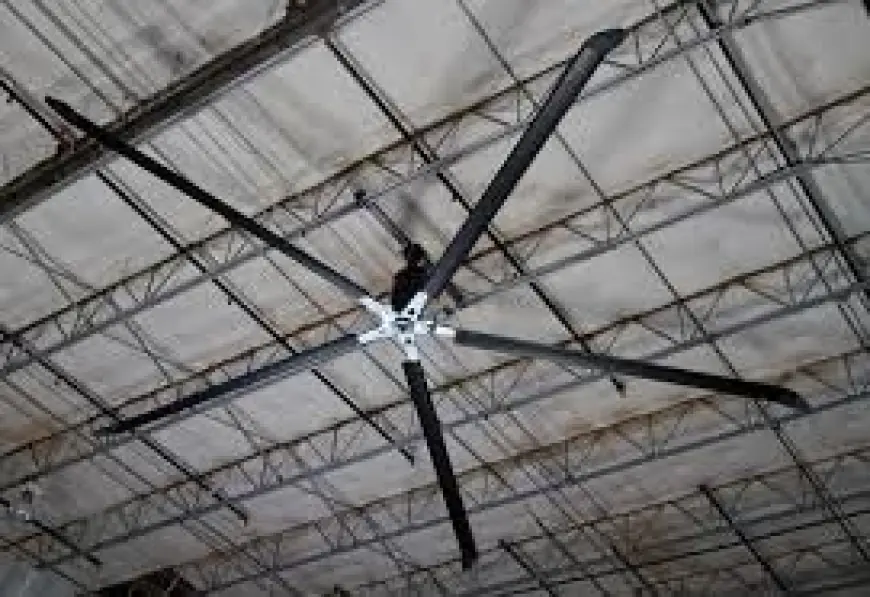How to Choose the Right HVLS Fan Supplier for Your Business Needs
When managing large facilities such as warehouses, manufacturing plants, agricultural spaces, or commercial complexes

When managing large facilities such as warehouses, manufacturing plants, agricultural spaces, or commercial complexes, effective ventilation is essential for maintaining comfort, air quality, and energy efficiency. High Volume Low Speed (HVLS) fans have emerged as a go-to solution for these challenges, offering powerful airflow, reduced energy costs, and a healthier indoor environment. However, choosing the right HVLS fan supplier is just as important as selecting the fan itself. The right supplier not only provides quality products but also ensures proper installation, service, and long-term reliability.
In this article, we’ll explore the key factors businesses should consider when selecting an HVLS fan supplier to meet their specific needs.
1. Assess Product Quality and Technology
Not all HVLS fans are built the same. A reliable supplier should offer fans designed with advanced technology, high-quality materials, and rigorous testing standards. Look for:
-
Durable construction using aluminum or steel blades with protective coatings to withstand heavy use.
-
Quiet operation with noise-reducing technology.
-
Energy efficiency features such as direct-drive motors instead of gear-driven systems.
-
Smart controls for adjusting fan speed, integrating with HVAC systems, or monitoring energy consumption.
Suppliers who prioritize innovation and superior engineering will provide fans that last longer and perform more efficiently in large-scale environments.
2. Check Industry Experience and Expertise
HVLS fans are highly specialized products, and a supplier with years of experience will better understand your facility’s unique ventilation needs. An experienced supplier can recommend fan sizes, blade designs, and placement strategies tailored to your space. They will also be aware of industry-specific challenges, whether you’re running a logistics warehouse, agricultural barn, or commercial gym.
Always look for suppliers with a strong track record and positive reputation across industries similar to yours.
3. Evaluate Customization Options
Every facility has different requirements, and a one-size-fits-all approach may not work. The best HVLS fan suppliers offer customization in terms of:
-
Fan diameter and size (typically ranging from 7 to 24 feet).
-
Mounting options to accommodate varying ceiling heights and structures.
-
Control systems such as remote access, wall panels, or building automation integration.
-
Color and finish choices to align with your facility’s aesthetics.
A supplier willing to tailor solutions ensures you’re not just buying a product but an airflow system designed for maximum efficiency.
4. Review Installation and After-Sales Support
HVLS fan installation requires precision and technical expertise to guarantee performance and safety. Choose a supplier who offers:
-
Professional installation services with certified technicians.
-
Maintenance programs to extend fan life and optimize performance.
-
Quick response times for repairs or troubleshooting.
-
Comprehensive warranties covering parts and labor.
Suppliers that provide full lifecycle support show their commitment to long-term customer satisfaction, not just one-time sales.
5. Consider Energy Efficiency and ROI
Businesses invest in HVLS fans largely for their energy-saving benefits. A trustworthy supplier will be able to provide:
-
Energy savings reports based on your facility size and conditions.
-
Case studies showing real-world reductions in cooling/heating costs.
-
Guidance on ROI calculations to demonstrate how the fan system pays for itself over time.
The supplier should position themselves as a partner in helping you achieve sustainability and cost-efficiency goals.
6. Look for Strong Customer Reviews and References
Testimonials and reviews are invaluable in assessing a supplier’s credibility. Ask for references from clients in your industry or check online feedback. Reliable suppliers are transparent about their track record and can demonstrate customer satisfaction through case studies, repeat business, or industry awards.
7. Compare Pricing and Value
While cost is always an important factor, businesses should avoid focusing solely on the lowest price. Instead, evaluate the overall value the supplier provides. Consider:
-
Product quality and longevity
-
Installation and service support
-
Warranty coverage
-
Customization capabilities
The cheapest option may lead to higher maintenance costs and shorter fan lifespan, while a quality-focused supplier ensures better long-term savings.
8. Ensure Compliance with Safety Standards
Safety is paramount in large facilities. The right supplier should provide HVLS fans that comply with international safety standards and certifications. Features like fire-resistant materials, secure mounting systems, and blade safety edges are indicators of a supplier’s commitment to safety.
Conclusion
Choosing the right HVLS fan supplier is about more than just purchasing a fan—it’s about investing in a long-term solution that improves airflow, energy efficiency, and workplace comfort. By focusing on factors such as product quality, supplier expertise, customization, installation support, and after-sales service, businesses can ensure they get the best value and performance from their HVLS fans.
The right supplier will act as a partner, helping you design, install, and maintain a system that enhances both operational efficiency and employee well-being.
If your business is considering HVLS fans, take the time to evaluate suppliers carefully. The right choice today can result in years of cost savings, improved working conditions, and peace of mind.
What's Your Reaction?
 Like
0
Like
0
 Dislike
0
Dislike
0
 Love
0
Love
0
 Funny
0
Funny
0
 Angry
0
Angry
0
 Sad
0
Sad
0
 Wow
0
Wow
0
















































